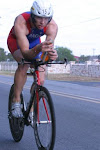
I swear I didn't doctor this photo by adding some extra flashes to that apple cinnamon PowerBar (or a fake finger to the bottom right of the frame). This is a rough approximation of the calories I consumed during yesterday's rehearsal of the St. George IM bike ride. No, I'm not in Utah right now, but with some careful route planning (and a helpful headwind) I was able to mimic what I hope to experience in 36 short days.
First of all, the ride will be difficult. Go have a look at
Gordo's impressions of the course—his writeup has me rethinking my goals (in a good way). I "rode" this course a few weeks ago using a Computrainer and the St. George Real Course Interactive Video. I rode the "course" (you only get to ride 67.7 miles of the course—the lolipop stick from the reservoir and the first loop of the lolipop) and, riding steadily, only managed 17 mph avg and 200W avg. There is a lot of climbing, and I think the patient rider will be rewarded.
Nutrition. When I raced Canada last year, training partner Guy Nelson asked "What's your nutrition plan?" and I kinda shrugged and said "Double my HIM plan?" Knowing how that worked out I decided, this year, to put a little more effort into my planning.
The first step when planning your nutrition is to figure out how many calories you'll probably burn in an hour of exercise. The fuzzy rule of thumb is 1 g of carbohydrate per kg of body weight per hour. I'm a fairly stout 80 kg with a good amount of muscle mass (former trainer partner Dereck Treadwell once said: "You look like a big guy, I mean a
big guy, on the bike."), so I might burn a bit more than the average triathlete at that weight. So that's 80 g of carbohydrate per hour, or 320 calories worth of food. You will want a little protein in that mix (and most energy bars come with some amount of protein), so figure another 10g of protein per hour, and I've got 360 calories to consume per hour.
I set out yesterday to ride six hours (came in about 1/2 an hour short, but that story will get posted with the label "double flat!"), so I aimed for 2160 total calories. My workout involved five separate efforts: 2 @ HIM pace for 20k with 15' recovery, and then 3x45' IM pace efforts with 5' recovery. Those fifteen and five minute windows were my chances to refuel (it's hard to unwrap a powerbar at 40 kph). Here's my menu (disclosure—I'm sponsored by PowerBar and nuun):
6 PowerBars of various flavors (1380 calories—good mix of carbohydrate and protein)
3 PowerGels of various flavors (330 calories—all carbohydrate)
1 BabyRuth bar (I love those things!) (around 250 calories, good mix of carbohydrate, salt, and fat)
Total intake: 1960 calories, about 100 short, but I did double flat at 5:30 and call it a day, so I hit my intake pretty much spot on.
And here was the plan, remember that you should get the calories in
at any point during the hour, but don't start trying to play catchup—you can't. Also notice that I was a little low in the first 1.5 hours, that's because your body will still be using the 90 minutes of glycogen stored in your muscles:
2 hours before ride: 750 calorie breakfast consisting of 1 cup yogurt, 1 cup milk, 2 cups Cheerios, 1 banana, 2 T honey, 1 PowerBar.
@30' (2/3 through warmup) 1 PowerBar
@76' (after first 20k TT) 1 PowerBar, 1 PowerGel
@127' (after second 20k TT) 1 PowerBar
@150' (before first 45' IM pace interval) 1 PowerGel
@195' (after first IM interval) 1 PowerBar
@245' (after second IM interval) 1 PowerBar, 1 Baby Ruth bar (note this came at 120 k, right where I'd get my special needs bag)
@300' (after third IM interval) 1 PowerGel
I felt great as I passed the 100-mile mark (right at 310') on this ride, a sign that my nutrition was in a good place. Still, to think that just eating right will have your legs fresh for the run will have you visiting the PortaJohns, trying to unclog your stuffed but not hydrated system. Here's what I did for hydration:
14 tabs of
nuun dissolved in 140 oz of water (they recommend 1 tablet per 16 oz of water but A) I'm a big guy who sweats a lot and B) I like the taste of concentrated nuun). Here's the data from the nuun website on what's in one tablet of nuun (and then, in parentheses, how much of each nutrient I received):
Sodium (carbonates) 360.0 mg (5040 mg or 5 g)
Potassium (bicarbonate) 100.0 mg (1400 mg or 1.4 g)
Calcium (carbonate) 12.5 mg (175 mg)
Magnesium (sulfate) 25.0 mg (350 mg)
Vitamin C 37.5 mg (525 mg)
Vitamin B2 500mcg (700 mcg)
I drank about 1-1.5 oz of fluid every five minutes during the entire ride, even during efforts. As a result of this nutritional rehearsal, I feel confident about my plan going into IM St. George...now, how will I carry 140 oz of liquid with me without using a CamelBak?


